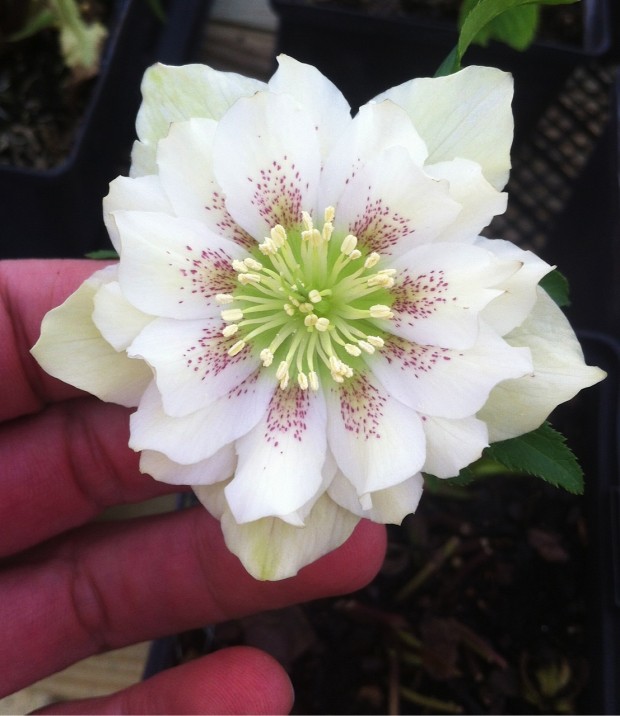 I am embarrassed to complain, given what the people in Boston have endured this winter, but I will say it. We have had a long tough winter. We had the better part of Boston’s snow last year. This year, no heart or record breaking snow, but plenty of snow nonetheless. The snow I could plow through, and shrug off. The tough part was an interminable run of very cold weather, lots of it below zero. Dressing for a trip outdoors was an event the likes of which was almost intolerable. Boots, gloves, coat, hat, and lots of layers in between. All of this piling on took lots of time. That effort did not come to much good-the cold was bone chilling. No one took the arctic winter poorer than the corgis. Every day they would plead with me to change the channel. They were bored and irritable. It was a daily thing, wanting to be let out every possible door to the outside-in hopes one would reveal habitable weather. The spring in Michigan does not come easy or in an orderly fashion. Mother nature takes her time, deciding when the season will change from winter to spring. We have been made to wait.
I am embarrassed to complain, given what the people in Boston have endured this winter, but I will say it. We have had a long tough winter. We had the better part of Boston’s snow last year. This year, no heart or record breaking snow, but plenty of snow nonetheless. The snow I could plow through, and shrug off. The tough part was an interminable run of very cold weather, lots of it below zero. Dressing for a trip outdoors was an event the likes of which was almost intolerable. Boots, gloves, coat, hat, and lots of layers in between. All of this piling on took lots of time. That effort did not come to much good-the cold was bone chilling. No one took the arctic winter poorer than the corgis. Every day they would plead with me to change the channel. They were bored and irritable. It was a daily thing, wanting to be let out every possible door to the outside-in hopes one would reveal habitable weather. The spring in Michigan does not come easy or in an orderly fashion. Mother nature takes her time, deciding when the season will change from winter to spring. We have been made to wait.
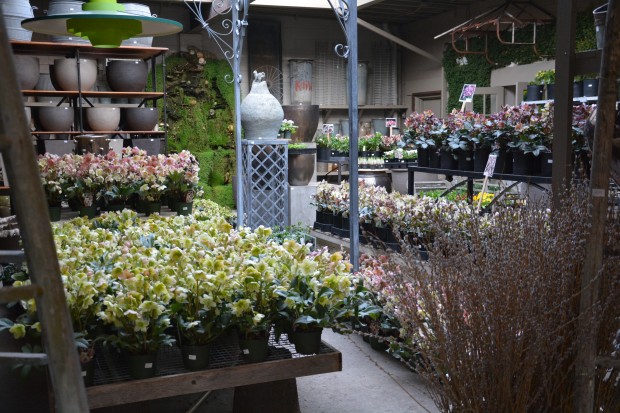 We feel better about the weather, having worked to introduce our own indoor version of spring. In March, we take delivery of over 1000 hellebores from growers all over the US and Canada. We invite gardeners in our area to come, browse and review our collection, and speak for them. We mean to offer gardeners a respite the winter, with our hellebore festival. It takes a few days, but our greenhouse space is starting to look like and smell like a garden. Our March weather seems to be moderating-we have hope we are on a track to spring. But if the spring outdoors is practically still weeks off, we have a version of spring in our greenhouse. Should the spring be a few weeks off, the hellebores are content to reside in sunny window until the ground outside can be worked.
We feel better about the weather, having worked to introduce our own indoor version of spring. In March, we take delivery of over 1000 hellebores from growers all over the US and Canada. We invite gardeners in our area to come, browse and review our collection, and speak for them. We mean to offer gardeners a respite the winter, with our hellebore festival. It takes a few days, but our greenhouse space is starting to look like and smell like a garden. Our March weather seems to be moderating-we have hope we are on a track to spring. But if the spring outdoors is practically still weeks off, we have a version of spring in our greenhouse. Should the spring be a few weeks off, the hellebores are content to reside in sunny window until the ground outside can be worked.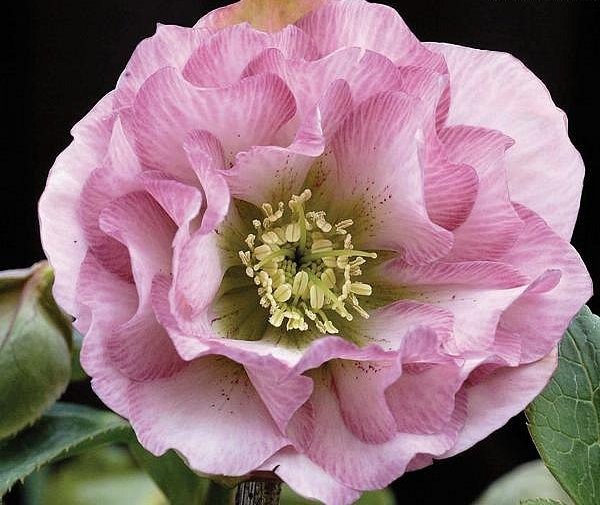 Hellebores are a hardy perennial in our zone. Many of them are hardy in zone 4; most of them are eminently hardy in zone 5. I treasure them, as they are the first perennial to bloom in my garden in April. Hellebore foliage is large, and will persist long past the fall and into the winter. In warmer zones, the foliage is evergreen. The Orientalis hybrids throw their bloom stalks very early in the spring, arising out of the declining foliage from the previous season. The new foliage which is to come after the blooming is lush and substantive. They are tolerant of a wide range of conditions in the garden. I grow them in full sun, but I water them when they need it. They are equally as happy in a lightly shaded location. They can live and increase in a garden for many years, without any need for division. Deer do not touch them. The flowers are surprisingly large, and quite beautiful.
Hellebores are a hardy perennial in our zone. Many of them are hardy in zone 4; most of them are eminently hardy in zone 5. I treasure them, as they are the first perennial to bloom in my garden in April. Hellebore foliage is large, and will persist long past the fall and into the winter. In warmer zones, the foliage is evergreen. The Orientalis hybrids throw their bloom stalks very early in the spring, arising out of the declining foliage from the previous season. The new foliage which is to come after the blooming is lush and substantive. They are tolerant of a wide range of conditions in the garden. I grow them in full sun, but I water them when they need it. They are equally as happy in a lightly shaded location. They can live and increase in a garden for many years, without any need for division. Deer do not touch them. The flowers are surprisingly large, and quite beautiful.
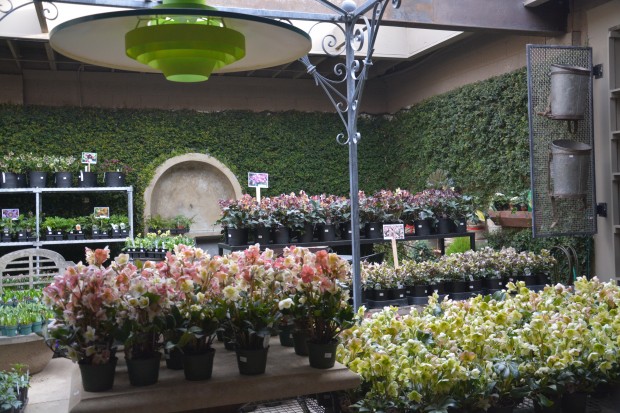 The flowers of the hellebores my Mom grew in her garden 50 years ago did not look like these. The blooms were nodding-down facing. To enjoy her bell shaped flowers required getting down on the ground to look up into their faces. She would cut them, and put them in a vase in the kitchen window. Her favorites were the white and green flowered hellebores, as the pink cultivars were a muddy not so appealing pink. It took years to grow on a hellebore to a decent size, as they were only available as young starts. There was always lots more foliage than flowers. Nonetheless, she loved the look of them in her shade/wildflower garden. Their foliage would last the entire summer and beyond, unlike the spring bulbs and ephemeral wildflowers she cultivated. The hellebore world has changed dramatically since then.
The flowers of the hellebores my Mom grew in her garden 50 years ago did not look like these. The blooms were nodding-down facing. To enjoy her bell shaped flowers required getting down on the ground to look up into their faces. She would cut them, and put them in a vase in the kitchen window. Her favorites were the white and green flowered hellebores, as the pink cultivars were a muddy not so appealing pink. It took years to grow on a hellebore to a decent size, as they were only available as young starts. There was always lots more foliage than flowers. Nonetheless, she loved the look of them in her shade/wildflower garden. Their foliage would last the entire summer and beyond, unlike the spring bulbs and ephemeral wildflowers she cultivated. The hellebore world has changed dramatically since then.
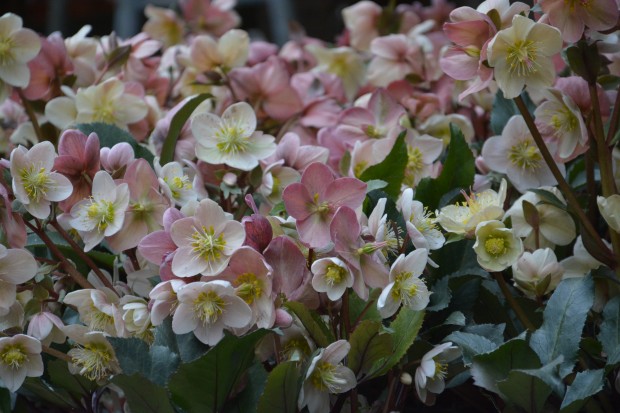 This group of plants have been the subject of intense breeding all over the globe. A lot of attention has been devoted to breeding plants who flowers are out and up facing. Some breeders have produced strains of hellebores with double flowers, or unusual coloration. Marietta and Ernie O’Byrne, who own Northwest Garden Nurseries, have bred some stunning strains of hellebores. The same can be said for Judith and Dick Tyler who own and operate Pine Knot Farms. These names are just two of a long list of hellebore enthusiasts who breed and sell plants in Belgium, Germany, England, Japan, the US and Canada.
This group of plants have been the subject of intense breeding all over the globe. A lot of attention has been devoted to breeding plants who flowers are out and up facing. Some breeders have produced strains of hellebores with double flowers, or unusual coloration. Marietta and Ernie O’Byrne, who own Northwest Garden Nurseries, have bred some stunning strains of hellebores. The same can be said for Judith and Dick Tyler who own and operate Pine Knot Farms. These names are just two of a long list of hellebore enthusiasts who breed and sell plants in Belgium, Germany, England, Japan, the US and Canada.
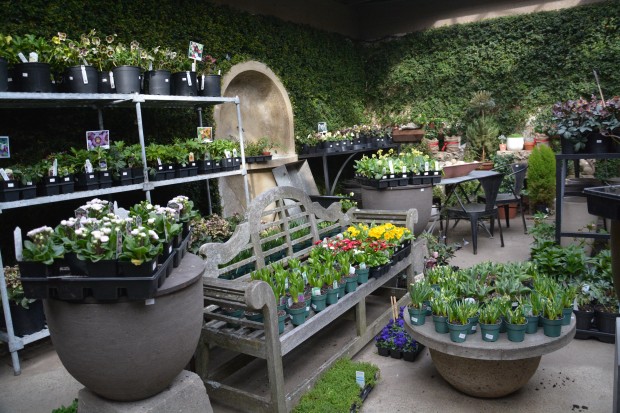 Most of the plants in the greenhouse are hybrids of helleboris Orientalis. Helleborus Orientalis is not a species of hellebore, strictly speaking. It is a plant which is an interspecific cross from a number of different species hellebores-the O’Byrnes think maybe more than 16 species have a part in what is properly known as helleborus x hybridus. They do not come true from seed, so many of these named varieties are referred to as such and such “strain” of hellebore. Given that the plants may take 3 years to flower, many breeders sell their young plants with pictures that show the possible color range. The advent of tissue culture has made it possible to clone specific plants, and make them available to interested gardeners. My discussion of the history and science is quite limited-for a detailed look at hellebores, do visit the website of Plant Delights Nursery. Some of the hellebores we have came from a trip Rob made there a few weeks ago. Tony Advent does a terrific job making great garden plants available to serious gardeners. He also does a great job of providing an overview of the history and proper culture of the plants he sells.
Most of the plants in the greenhouse are hybrids of helleboris Orientalis. Helleborus Orientalis is not a species of hellebore, strictly speaking. It is a plant which is an interspecific cross from a number of different species hellebores-the O’Byrnes think maybe more than 16 species have a part in what is properly known as helleborus x hybridus. They do not come true from seed, so many of these named varieties are referred to as such and such “strain” of hellebore. Given that the plants may take 3 years to flower, many breeders sell their young plants with pictures that show the possible color range. The advent of tissue culture has made it possible to clone specific plants, and make them available to interested gardeners. My discussion of the history and science is quite limited-for a detailed look at hellebores, do visit the website of Plant Delights Nursery. Some of the hellebores we have came from a trip Rob made there a few weeks ago. Tony Advent does a terrific job making great garden plants available to serious gardeners. He also does a great job of providing an overview of the history and proper culture of the plants he sells.
http://www.plantdelights.com/Article/Hellebore-Lenten-Rose/Hellebores/Christmas-Rose/
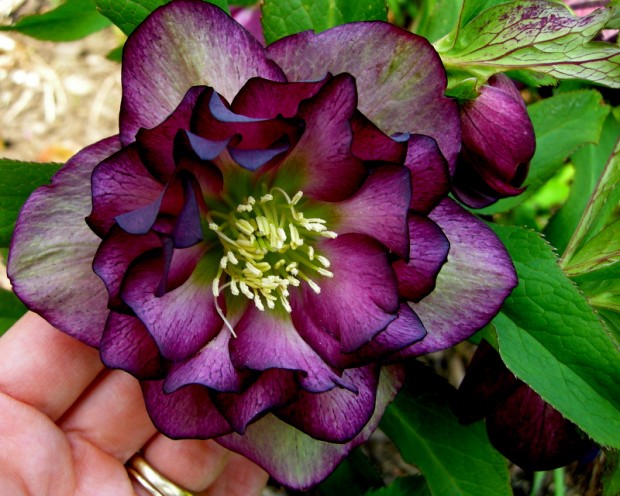 The hybridizing of hellebores to produce stronger growing and beautifully flowered hellebore cultivars has been a shot heard round the world. Today, hybridizers in Europe, Canada, Japan and the US have created cultivars featuring study and garden worthy plants, and breathtaking flowers. The vast majority of the plants we have available now are cultivars that have a proven performance record. And we feature large sized plants that are old enough to produce a good crop of flowers from the start. But we also have a limited number of one of a kind plants that would appeal to a hellebore collector.
The hybridizing of hellebores to produce stronger growing and beautifully flowered hellebore cultivars has been a shot heard round the world. Today, hybridizers in Europe, Canada, Japan and the US have created cultivars featuring study and garden worthy plants, and breathtaking flowers. The vast majority of the plants we have available now are cultivars that have a proven performance record. And we feature large sized plants that are old enough to produce a good crop of flowers from the start. But we also have a limited number of one of a kind plants that would appeal to a hellebore collector.
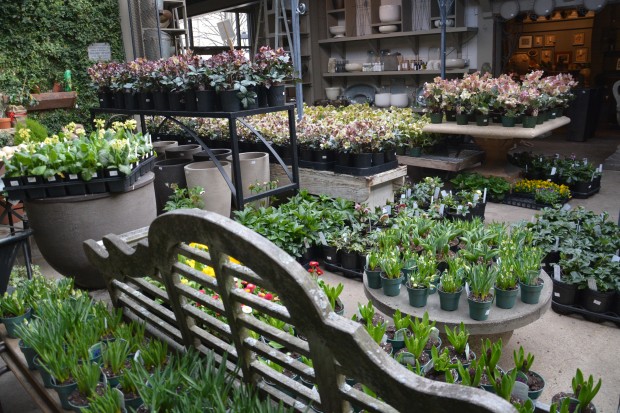 I did buy a collection of named hellebores last February from a nursery in British Columbia, Canada, named Fraser’s Thimble Farms. They ship small plants to the US, bare root. I did have to pot them up, and baby them along in the window sill of my drawing studio until they took hold. I finally planted the entire lot of them in a patch in my garden that used to be occupied by some not so wonderful looking yews. Just yesterday I could see that the snow had melted, and all of those small plants look like they survived our winter. I am not expecting all of them to bloom this spring, but I have hopes.
I did buy a collection of named hellebores last February from a nursery in British Columbia, Canada, named Fraser’s Thimble Farms. They ship small plants to the US, bare root. I did have to pot them up, and baby them along in the window sill of my drawing studio until they took hold. I finally planted the entire lot of them in a patch in my garden that used to be occupied by some not so wonderful looking yews. Just yesterday I could see that the snow had melted, and all of those small plants look like they survived our winter. I am not expecting all of them to bloom this spring, but I have hopes.
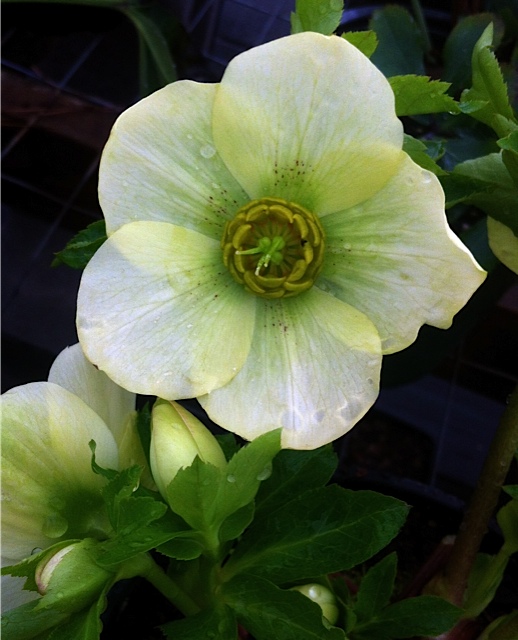 We do have gardeners come in who are not familiar with hellebores. This is not so surprising. Some nurseries are reluctant to carry plants that take 3 years to flower from seed, or are already out of bloom in May. The good news for gardeners is what appears to be the flower is actually a modified calyx, or petal like structures that surround the actual flower. The flower is in the center, and these true petals will drop when the flowering period is over. But the calyx persist on the plants for months, giving the appearance of a really long bloom time. Still, I try to site hellebores in spots that make them easy to view in early spring.
We do have gardeners come in who are not familiar with hellebores. This is not so surprising. Some nurseries are reluctant to carry plants that take 3 years to flower from seed, or are already out of bloom in May. The good news for gardeners is what appears to be the flower is actually a modified calyx, or petal like structures that surround the actual flower. The flower is in the center, and these true petals will drop when the flowering period is over. But the calyx persist on the plants for months, giving the appearance of a really long bloom time. Still, I try to site hellebores in spots that make them easy to view in early spring.
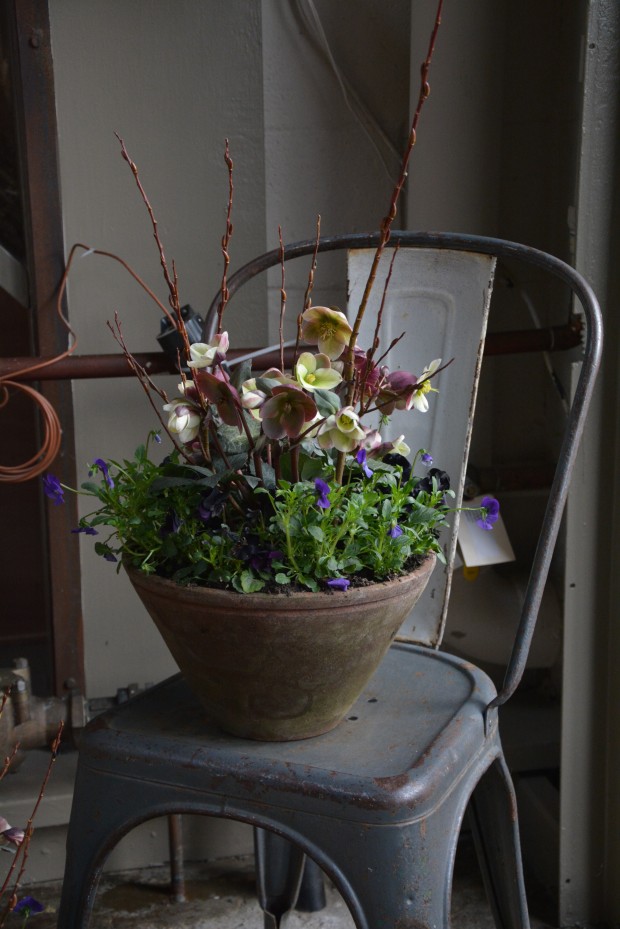 Hellebores also make great container plants. Everything we ordered for our collection is in, and our Hellebore festival is slated for Friday March 20 through Sunday March 22. Can you come ahead? Of course.
Hellebores also make great container plants. Everything we ordered for our collection is in, and our Hellebore festival is slated for Friday March 20 through Sunday March 22. Can you come ahead? Of course.
They are one of my favorites too. I hope to come select a few for my own garden.
Dear Mario, Be sure to ask for me if you come. I would love to see you. best, Deborah
I love the color of the purple flower. What is this variety name? Do you have many of this color?
Dear Carol, this particular plant is gone, and was from a strain, not from tissue culture. We do have Onyx Odyssey, and the Ballerina Ruffles Strain. best, Deborah
F-A-V-O-R-I-T-E plant to behold in springtime. I opened this email and was mentally flooded with the scent of soil and living plants. I really need that. Still too much white stuff on the ground here in NY. In the words of the immortal Frog (or was it Toad?) “Spring is just around the corner.” Bring it ON already.
Hi Deborah, I’m a transplanted Detroiter. I now live in Tampa, FL. Love your blog! Brings back memories. You have no idea how much I’d love to see your hellebores, gorgeous! My next trip up north I plan on visiting.Do you think I could grow hellebores here? Here’s to Spring!!
I am absolutely delighted with the quality of the hellebores that I was able to purchase from DGW during Spring 2014. I am eager to see what the ‘Onyx’ hellebores will look like during Spring 2015, placed within drifts of snow drops. We will see who will bloom first, the hellebores, or the snow drops! Needless to say, I will be adding to my small, but growing collection this year. Thank you for doing all your research and for making these wonderful plants available!
To be bathed in hellebores is a yearly indulgence of the first order.
Thank you.
Dear Michael, I do love them so. My biggest clumps have been in at least 10 years, all from the Royal Heritage strain. The colors are muddy, and all of the flowers face downwards-but I love them anyway. My newer varieties are babies-it will be a few years. What a great plant this would be to put on a slope above one’s view! best, Deborah
Beautiful flowers, greenery here in Naples but nothing beats the hellebores and so many additional perennials in our Michigan gardens. Very sorry I can’t be there for the show – I’ll be there soon as I can so save something for me !
p.s. No helebores like these in or around Naples!
Dear Madeline, I remember you bought a collection of yellow hellebores a couple of years ago-I hope you get some good flowers this year. all the best, Deborah
To me, the Hellebore is a magical, mystery plant that I have never had the pleasure to grow. I just need to study them, I guess. I’m always awestruck when I see one because of my horrible luck. Living in Chicago, snow and icy cold is also the rule. Maybe this year, I will try again!
I live in Madison, WI and have had good luck. Give them another try.
What a glorious treat shoppers will have at your shop. And certainly a visual treat for us readers.
I have lots of 15-year old hellebores in my California back yard. They begin to bloom in February, but usually last until Easter. We love them here because they will grow under our native oaks – most plants shrink in horror!
I love the hellebores in my garden. They are evergreen here in California. But I long to see your annual hellebores festival in person. Maybe someday.
Way more varieties of the Hellebores than I thought possible, those beautiful pinks and deep rose ones! I think I have only really seen the white and greenish varieties. I love early blooming flowers- they seem so hopeful after the perils of winter. Sending warm weather thoughts your way.
Thanks,
Mary
My garden is in Michigan. Do you recommend removing the previous year’s foliage at the end of Winter, before the new growth sets in, pretty much like one would do for most perennials? Or do you leave the old foliage on? Thank you for your advice!
Dear Antoine, I leave the foliage intact all winter, and only cut it back when I see the flower stalks beginning to grow. I think the old foliage protects the plant in the winter. That said, I have on occasion cut off flower stalks by accident, waiting to long to get rid of the foliage in the spring. Hope this helps, Best, Deborah
Very helpful, thank you!
Hi, I planted some plants last summer and this spring no foliage is visible, have I lost them?
This is my second attempt in this area of my garden, what could be wrong?
It is a nice area under a maple, my hydrangea do well here. The primrose are coming up,
help!
Deborah-
Such a gorgeous look at your Hellebores- such magnificent doubles and rufflies! The simpler single blooms still have their place, too, especially the clear pale yellow ones! This is a flower variety I will have to add to my U.P. garden. We rarely see them offered here, probably because there currently aren’t any garden venues open that early! Perhaps mail order from your sources. I swear I caught a whiff of spring as I read your column- thank you for that! 🙂 I highly recommend taking the MSU Master Gardener course to any gardeners out there wishing to expand their knowledge; I completed it last December and loved it.
Carry on as we wait patiently for spring to arrive in the U.P. Sue
I love the hellebores in my garden and would love to be at your festival but it is still too cold for my California blood.
I see mine peeking out from under the snow as it recedes from along the the side of my home here in Harbor Springs. I just hope some critter does not come and enjoy the nice fresh leaves. I look forward to seeing them pop out.
Great to know I can purchase so close to home. I purchased one last year from one of my nursery catelogues and was very pleased with it in the garden. So pleased I took a picture of the blooms. I look forward to adding more.
Nadine
I am coming to see you on Sunday and hope to be there when you open. I have a wild flower garden in perenial progress and want to add hellebores. It has rich soil and some of it can get wet in the Spring. What is the best soil type for the hellebore plants. I am wanting them to naturalize. They will be in a woodland setting. Deer wander through on my trails and I wonder if they can be an issue…Your photos are indeed eye candy. I can hardly wait to get there. I visited your shop last winter for the first time after reading about you on Gardenista and was delighted with what I saw and purchased.
Dear Lenore, deer do not touch hellebores – rest easy about this issue.They like woodland soil-soil that is loaded with compost.They like woodland conditions. Mine are in full sun, but I water. That said, they are very shade tolerant. I would say that they increase in size slowly. They will seed, provided you leave the calyx/flower heads on all summer. This is a perennial worth investing in. Sited properly, they are carefree. And rewarding. This is the first perennial to flower in my garden in the spring. all the best, Deborah
Greetings, Deborah;
And thanks so much for the photographic inspiration; the Hellebores here (north of Boston) are just budding up, in the odd places where the snow has returned finally to the aquifer.
I wonder if you might post the cultivar names with your exquisite photographs at some point?
Merci!
Dear Hilarie, I do try to post cultivar names-when I have time. This time of year moves so fast!! best, Deborah